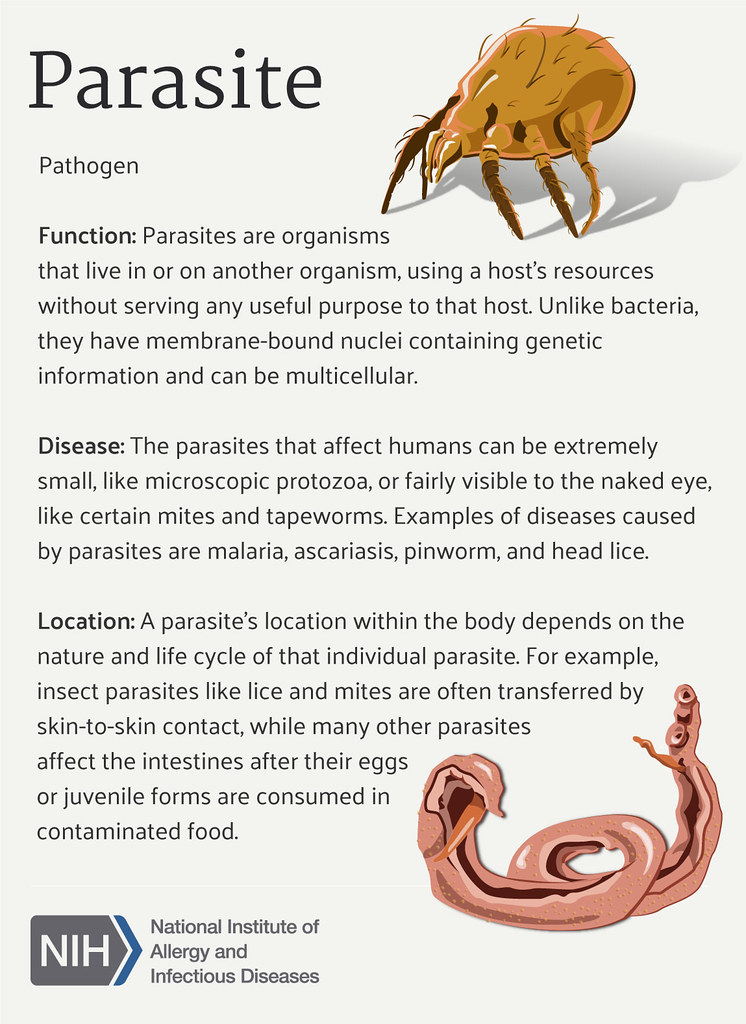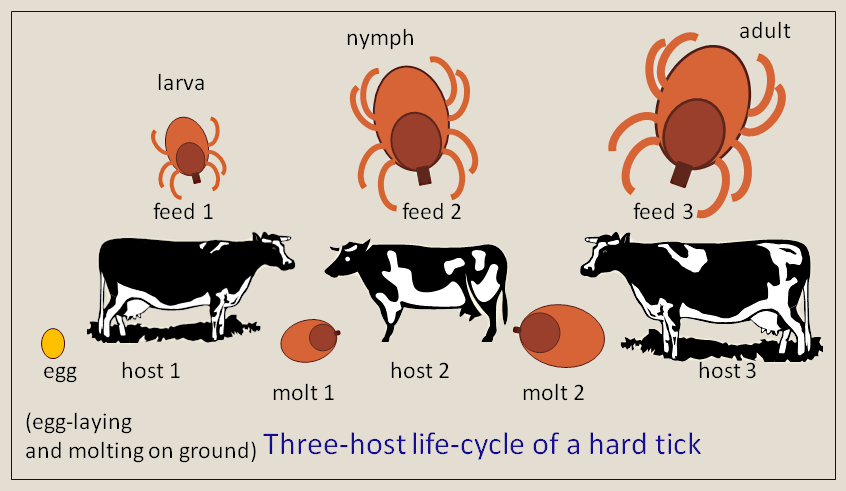Difference Between Parasite and Host
Parasitism is a form of antagonistic symbiosis with a metabolic dependence that has emerged secondary in the course of evolution. Parasites use individuals from other species, called hosts repeatedly and for a long period as a source of food and habitat. Parasitism is beneficial to the parasite and harmful to the host.
What is Parasite?
Parasite is an organism (plant, animal, fungus) that lives on the surface or inside another organism and feeds on it. The parasite develops at the expense of the host, which gradually loses its vitality. Unlike predators, parasites do not kill the organisms they use for food. In some cases may cause their death but after a certain period.
Parasites can be plants, animals, and fungi. According to their localization parasites are divided into two main groups:
- Endoparasites – live/feed inside the host’s body;
- Ectoparasites – live/feed on the host’s surface.
According to their ontogenesis and way of life, parasites are:
- Obligate – they parasitize to carry out their entire life cycle (Trichnella spiralis, Taeniarhynchus saginatus, etc.);
- Facultative – can exist both as parasites and as free-living organisms (Strongyloides stercoralis, Ancylostoma duodenalae, etc.);
- Pseudoparasites – fall into the host by chance, most often with food (larvae of flies, etc.).
According to the time span of the parasitism, the parasites are:
- Temporary – larvae of some nematodes (Ascaris lumbricoides, Ancylostoma duodenale), etc.
- Permanent – intestinal helminths (nematodes, cestodes, and trematodes), etc.;
- Transit – the larvae of some parasites migrateс through organs and systems (larvae of Ascaris lumbricoides, Ancylostoma duodenale), etc.
The factors that determine the course of the parasitosis are the pathogenicity, species characteristics, adaptations, quantity, reproductive potential, localization of the parasites, etc.
What is Host?
Host is an organism that serves as a source of food and habitat to a parasite.
Depending on their role in the development and existence of the parasites, hosts can be divided into obligate, paratenic, and potential.
Obligate are hosts without which the parasite cannot complete its development cycle and ensure its existence as a species. Depending on the stage of development of the parasite, obligate hosts are divided into:
- End host – here the parasite reaches sexual maturity and reproduces sexually. For single-host parasites, this is the only host;
- Intermediate host – here develop part of the larval stages of two-host and three-host parasites. In some parasites is observed asexual reproduction of larval stages in the intermediate host;
- Additional host – here takes place the second phase of larval development of the three-host parasites.
Depending on the living conditions offered by obligatory hosts, they are divided into:
- Specific (typical) host – the parasite finds the most favorable living conditions;
- Non-specific (atypical) host – conditions are not optimal and the survival rate is low.
A paratenic host can host a particular phase of the development of a parasite but does not provide all the necessary conditions for its entire development. The parasite can exist without this host. Depending on the development of the parasite within the paratenic host, they are divided into:
- Euparatenic host – the parasite does not develop in this host;
- Paraparatenic host – partial development begins;
- Metaparatenic host – partial development ends.
Depending on the further development of the parasite, paratenic hosts are:
- Tank host- a paratenic host that can transmit the parasite to an obligatory host.
- Abortive host – a paratenic host that releases the parasites in the stage that they have entered it and cannot transmit the invasion to an obligatory host;
- Captive host – a paratenic host in which the larval form of a parasite enters without being able to be transmitted to an obligatory host.
The potential hosts can provide a favorable environment for the development of a parasite, but cannot naturally be infected due to the lack of ecological connection.
Parasites have a negative effect on the survival and the physical condition of the hosts. They are an important factor influencing the dynamics of hosts’ populations and their evolution. Parasites can harm the host by using it as a source of nutrients or with the excreted metabolites. Indirect impacts include adverse effects on certain reproductive parameters, transmission of various diseases, etc. In some cases, parasites can cause the death of the hosts.
The factors that determine the course of the parasitosis are the condition of the immune system, protective reflexes, immunopathological reactions, hosts’ nutrition, concomitant diseases, etc. If the host is human important factors are the lifestyle, culture, level of health care, etc.
Difference Between Parasite and Host
Definition
Parasite: Parasite is an organism that lives on the surface or inside another organism and feeds on it.
Host: Host is an organism that serves as a source of food and habitat to a parasite.
Types
Parasite: According to their localization parasites are endoparasites or ectoparasites; according to their ontogenesis and way of life, parasites are obligate, facultative or pseudoparasites; according to the time span of the parasitism, the parasites are temporary, permanent or transit.
Host: Depending on their role in the development and existence of the parasites, hosts can be divided into obligate, paratenic, and potential; depending on the stage of development of the parasite, obligate hosts are divided into end, intermediate, and additional host; depending on the development of the parasite within the paratenic host, they are divided into euparatenic, paraparatenic, and metaparatenic hosts.
Impact
Parasite: The parasite benefits from the host, using it as a source of food and habitat.
Host: Parasites have a negative effect on the survival and the physical condition of the hosts. In some cases, parasites can cause the death of the hosts.
Influencing factors
Parasite: The factors that determine the course of the parasitosis are the pathogenicity, species characteristics, adaptations, quantity, reproductive potential, localization of the parasites, etc.
Host: The factors that determine the course of the parasitosis are the condition of the immune system, protective reflexes, immunopathological reactions, hosts’ nutrition, concomitant diseases, etc. If the host is human important factors are the lifestyle, culture, level of health care, etc.
Parasite Vs. Host: Comparison Chart
Summary of Parasite Vs. Host:
- Parasitism is a form of antagonistic symbiosis with a metabolic dependence that has emerged secondary in the course of evolution.
- Parasite is an organism that lives on the surface or inside another organism and feeds on it.
- Host is an organism that serves as a source of food and habitat to a parasite.
- According to their localization parasites are endoparasites or ectoparasites; according to their ontogenesis and way of life, parasites are obligate, facultative or pseudoparasites; according to the time span of the parasitism, the parasites are temporary, permanent or transit.
- Depending on their role in the development and existence of the parasites, hosts can be divided into obligate, paratenic, and potential; depending on the stage of development of the parasite, obligate hosts are divided into end, intermediate, and additional host; depending on the development of the parasite within the paratenic host, they are divided into euparatenic, paraparatenic, and metaparatenic hosts.
- The parasite benefits from the host, using it as a source of food and habitat. Parasites have negative effects on the survival and the physical condition of the hosts. In some cases, parasites can cause the death of the hosts.
- The factors that determine the course of the parasitosis are pathogenicity, species characteristics, adaptations, quantity, reproductive potential, localization of the parasites; condition of the immune system, protective reflexes, immunopathological reactions, concomitant diseases, nutrition of the host.
- Difference Between Gallstones and Cholecystitis - September 5, 2021
- Difference Between Constipation and Cramping - August 4, 2021
- Difference Between Whole Genome Sequencing and Microarray - May 6, 2021
Search DifferenceBetween.net :
Leave a Response
References :
[0]Chatterjee, K. Parasitology Protozoology and Helminthology. 13th edition. New Delhi: CBS Publishers & Distributors Pvt Ltd. 2019. Print.
[1]Lucius, R., B. Loos-Frank, R. Lane, R. Poulin, C. Roberts, R. Grencis. The Biology of Parasites. Hoboken: John Wiley & Sons. 2017. Print.
[2]Rej, K., R. Roy. Simplified Course on Parasitology and Immunology. Kolkata: NCBA. 2011. Print.
[3]Image credit: https://upload.wikimedia.org/wikipedia/commons/8/81/Three-host-life-cycle-hard-tick.png
[4]Image credit: https://live.staticflickr.com/4237/35361000821_63707c9e7c_b.jpg



